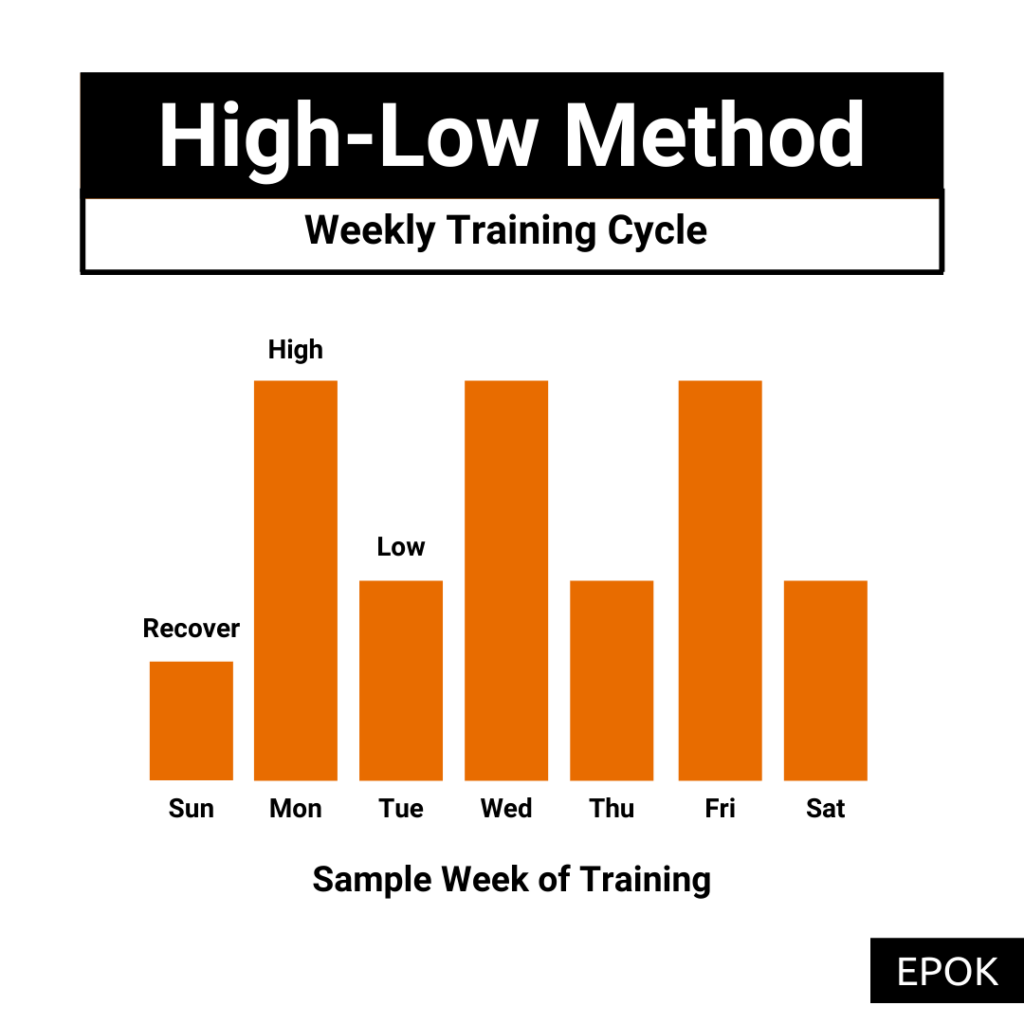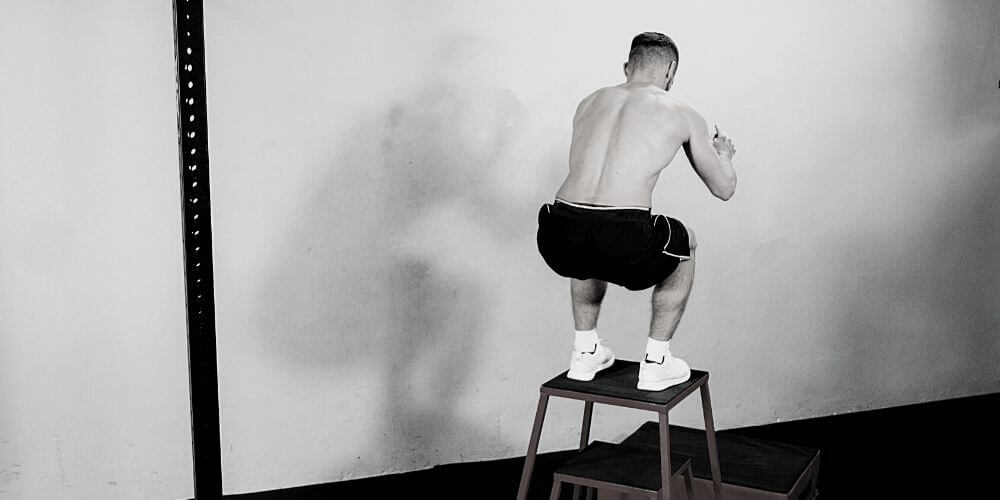So you want to jump higher, and you are willing to do whatever it takes?
Good, I like the intensity and to be honest that approach is what allows most athletes to succeed within their chosen sport. This thought process often translates itself into thinking that if a little of something is good, a lot of something is better, and to be honest a more is better approach isn’t entirely a bad idea with certain exercises. But does that apply to jump training?
Yes, jumping every day will increase your vertical jump, but volume and intensity need to be strategically programed to allow your body to recover.
Now don’t just read that sentence and start hammering out max effort verticals or depth jumps. This is a recipe for fatigue, poor performance, and potentially even injury. The amount of jumps, intensity of the exercises, and the types of exercises themselves all factor into being able to successfully jump every day and still increase your vertical jump height. I don’t even recommend the practice itself but since I know how athletes think and I often get asked questions like this, I feel obligated to give an educated answer.
My focus for this article is to provide advice on how jumping every day can be done safely and effectively to reach your vertical jump goals. I will include programming examples below.
Why Every Day?
Before adding anything new to your training it is important to ask yourself why is it a good idea. I find that a lot of athletes can’t answer that question and are oftentimes going through their training week with little to no direction. Basically winging it and assuming that what they are doing is going to work for them. This is never a good idea, but when we are talking about something as intense and explosive as jumping every day it can be a significant problem.
I understand the logic all too well, it comes from wanting to improve as fast as you can. If a little of something is good, then a lot of something has to be better…right?
Ehh maybe, maybe not. Like most things in life it depends on countless variables that are all interacting with each other. The main thing to avoid here is becoming an “in spite of” athlete, or someone who has succeeded at the highest levels of sport in spite of their training. This is a far too common occurrence in sports today, where gifted athletes make it through the convoluted youth sports landscape to find themselves inserted into the well organized systems found in college sports.
That may not sound so bad to you, but if we take a birds eye view of the situation you can’t help but wonder how many kids are losing opportunities because of development gaps or injury histories caused by this unorganized more is better approach to training.
The Details Matter
Now that my PSA on proper training is over, let’s start to unpack the question of whether or not jumping every day will increase your vertical jump. To be honest this comes down to the details of how you define jumping every day. Do you mean 50 total foot contacts from max effort plyometrics done 7 days a week or high, moderate, and low intensity jumping exercises adequately accounted for in sets and reps schemes across a 7 day period?
As you can see, the details and variables of how you go about jumping every day are the determining factors in whether or not doing so is a good idea.
The individual nature of trying to accomplish something like this makes it difficult to give a straight answer. There are nuances to specific tasks that are impossible to completely account for within the scope of a blog post. However, I will attempt to give an overview of what can go wrong when attempting to jump every day as a means of increasing your vertical jump, as well as a general guideline of how I would go about safely programming such an undertaking.

Think Twice Before Attempting Daily Plyometrics
To be clear, I am not a fan of this approach to improving vertical jump height. I actually think that it can be quite dangerous and will most likely not result in significant performance improvements. The negative effects of the grind culture to training can be seen all over youth sports, if you take a step back and look for it. We have drop out rates in sports that are higher than ever, injury rates that were unheard of years ago, and schedules that would make a pro athlete crumble, and yet for some reason we still think more is always better. With plyometrics or jump training I can confidently tell you that it is not.
These power training exercises are not designed to be executed every day because they are exposing the body to high amounts of force. This ability to rapidly generate force is massively beneficial in all sports and is often a component of virtually every decisive moment within competition, but without adequate recovery between reps, sets, and workouts we are not getting the desired training stimulus.
Fatigue Is An Issue
High intensity exercise requires a longer period of recovery between sessions. This is because of the stress that it puts on your body, specifically the nervous system. Your nervous system is the engine of your athletic ability, it is what drives all of the movements you are capable of performing within your sport. It is also unfortunately overlooked when planning out a training program by both athletes and their skill coaches.
It is this nervous system fatigue that will become the hardest thing to manage if you decide to attempt jumping every day. A general guideline for recovery time after performing a plyometric based workout is 48 to 72 hours, meaning that you should really only perform high intensity jump exercises 2 or 3 days per week.
Increased Risk Of Injury
There is an unpredictable nature to injuries that needs to always be factored in when discussing anything relating to their risk of occurrence. With that being said, I am completely comfortable saying that jumping every day can increase your chances of developing an injury.
It’s simple really, you are exposing your body to frequent, high intensity, high impact movements, that require adequate recovery between sessions. In the case of plyometrics you are really flirting with two variables, the fatigue caused by performing an exercise and the forces put on the body by each and every rep. This is why high intensity and high volume has never been a viable combo. It requires a detailed knowledge of programming to properly merge the two variables into an athlete’s training week.
Can You Jump Every Day And Improve Your Vertical?
Umm sure…
However I hope that by this point you understand why jumping every day can be a bad idea when performed in the traditional sense. An athlete that asks this question is looking for a better vertical like…yesterday. This is the problem and why I chose to spend the majority of this article explaining why all of this is a bad idea.
But enough of that, now I am going to finally break down how you can successfully jump every day to achieve vertical jump gains.
The key to pulling this off is in successfully controlling exercise selection and the number of repetitions. Traditional rest time is out the window in this scenario, so this ability is of the utmost importance if you are going to see the gains that you are looking for.
Strength Is A Prerequisite To Jumping Every Day
You absolutely need to have a solid foundation of strength before you attempt anything like this. Strength is a base component of virtually all athletic movement, without it you will not be able to withstand the intensity of daily plyos. It plays a big role in the execution of a proper vertical jump. Is it everything? No. However, it is a big part of the early stages of learning to execute the movement.
For all you younger athletes out there, if you can’t squat at least your bodyweight you have no business trying to jump on the daily.
What Types Of Jumps Should You Do?
You are going to have to vary your jumping exercises to successfully pull this off. Blasting depth jumps and consecutive plyometrics will put you on the fast track to injury. This means that the full spectrum of jump training needs to be used in order to manipulate the intensity of each day. Everything from low intensity and high volume jumps and hops to high elevated depth jumps will need to be utilized.
Here is a list of all of the jump types we will use to accomplish this goal:
- General Preparation Jumps (Low Intensity – High Volume): Repetitive jumps performed to a low height in relation to starting position, think jumping rope. These jumps are utilized to condition and prepare the tissues utilized in jumping. My personal favorite for this is the Altis rudiment hop series (Video below).
- Paused Jumps: These are jumps of any kind that involve a deliberate pause upon landing, think sticking the landing in gymnastics. The purpose of this type of jump is to teach the body to absorb force by exaggerating the eccentric portion of the movement.
- Traditional Plyometrics (High Intensity – Low Volume): Jumps performed with maximal intent in an often repetitive fashion. These are what we commonly think of when we refer to jump training.
- Specific Jumps: These are jumps specific to the goal of increasing your vertical jump height. The focus is on replicating either the testing event or the display of vertical jumping common within your sport. In most cases these will be variations of traditional plyometrics.
Sample Training Week: Jump Every Day To Vertical Jump Gains
This program is going to follow a high-low model, meaning that we will be alternating high intensity and low intensity days in relation to the effect on the nervous system. I am advising that this type of activity only occurs during the offseason due to the fact that in-season athletes are required to focus on far too much to successfully pull this off. I must also say that I do not recommend focusing on jumping every day for very long. There are a lot more physical qualities to work on when it comes to sports performance and the best athletes display high ability levels in most of them, not just one.
Now let’s get into the training…

The Program
This training week is based off how I would program an athlete that wanted to jump every day to accomplish their goal of a higher vertical.
- Day 1 – High
- Drop to Pause – 7 sets x 1 rep
- Choose a height that is above your current max vertical jump
- Simply drop down and stick the landing
- Running Vertical Jump – 15 sets x 1 rep
- Specific exercise
- Single Leg Low Hurdle Hop – 5 sets x 5 reps, each leg
- Drop to Pause – 7 sets x 1 rep
- Day 2 – Low
- Rudiment Hop Series
- Pogo Jumps for Height – 2 sets x 10 reps
- Day 3 – High
- Vertical Triple Jump – 5 sets x 3 reps
- Hurdle High Jumps – 3 sets x 3 reps
- Vertical emphasis
- Lateral Broad Jump – 3 sets x 3 rep, each side
- Day 4 – Low
- Rudiment Hop Series
- Single Leg Hurdle Hops w/ Pause – 3 sets x 3 reps
- Pause for 1 second before next rep
- Day 5 – High
- Fun Activity
- Do something closer to your sport or that has a competitive component
- Attempt to dunk, spike volleyballs, run-in vertical jumps, high jumps, max hurdle jumps, etc.
- Repetitions are based on when you feel mentally done with the activity
- Do something closer to your sport or that has a competitive component
- Fun Activity
- Day 6 – Low
- Lateral Cone Hop – 2 sets x 15 seconds, each leg
- Forward Pogo Jumps – 2 sets x 10 yds
- Backwards Pogo Jumps – 2 sets x 10 yds
- Lateral Pogo Jumps – 2 sets x 10 yds
- Day 7 – Recover
- Jump Rope – 5 sets x 90 seconds
So, Will Jumping Every Day Increase Your Vertical Jump?
I think the answer to this question is…it depends.
If you follow a training program similar to the sample week I included then I think you will be just fine jumping every day and will likely see an increase in your vertical jump. However, if you just want to perform repetitive plyometrics day in and day out you will end up fatigued with a low performance output. The answer really depends on how you attempt to get there.
My goal for this article was to attempt to address the more is better approach to training athletes today within the context of jump or plyometric training. I hope that the point is clear, you can do virtually anything within training so long as you know how to actually plan it out in a way that is both challenging and calculated. Never be arbitrary with your goals.
Thank you for reading. If you have any specific questions on this article please ask them here.

